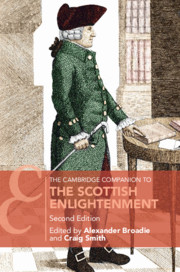Book contents
- The Cambridge Companion to the Scottish Enlightenment
- Series page
- The Cambridge Companion to the Scottish Enlightenment
- Copyright page
- Contents
- Contributors
- Acknowledgements
- Chronology of Events Relating to the Scottish Enlightenment
- Introduction
- 1 Several Contexts of the Scottish Enlightenment
- 2 Religion and Rational Theology
- 3 The Human Mind and Its Powers
- 4 Anthropology
- 5 Science in the Scottish Enlightenment
- 6 Scepticism and Common Sense
- 7 Moral Sense Theories and Other Sentimentalist Accounts of the Foundations of Morals
- 8 The Political Theory of the Scottish Enlightenment
- 9 Political Economy
- 10 Natural Jurisprudence and the Theory of Justice
- 11 Legal Theory in the Scottish Enlightenment
- 12 Sociality and Socialisation
- 13 Historiography
- 14 Art and Aesthetic Theory
- 15 Literature and Sentimentalism
- 16 The Impact on America
- 17 The Nineteenth-Century Aftermath
- Select Bibliography
- Index
- Series page
15 - Literature and Sentimentalism
Published online by Cambridge University Press: 04 October 2019
- The Cambridge Companion to the Scottish Enlightenment
- Series page
- The Cambridge Companion to the Scottish Enlightenment
- Copyright page
- Contents
- Contributors
- Acknowledgements
- Chronology of Events Relating to the Scottish Enlightenment
- Introduction
- 1 Several Contexts of the Scottish Enlightenment
- 2 Religion and Rational Theology
- 3 The Human Mind and Its Powers
- 4 Anthropology
- 5 Science in the Scottish Enlightenment
- 6 Scepticism and Common Sense
- 7 Moral Sense Theories and Other Sentimentalist Accounts of the Foundations of Morals
- 8 The Political Theory of the Scottish Enlightenment
- 9 Political Economy
- 10 Natural Jurisprudence and the Theory of Justice
- 11 Legal Theory in the Scottish Enlightenment
- 12 Sociality and Socialisation
- 13 Historiography
- 14 Art and Aesthetic Theory
- 15 Literature and Sentimentalism
- 16 The Impact on America
- 17 The Nineteenth-Century Aftermath
- Select Bibliography
- Index
- Series page
Summary
Sentimentalism in eighteenth-century Scottish literature reflected the ideas of moral philosophers like Francis Hutcheson, David Hume and Adam Smith, who argued that our sense of morality has its origins in feelings aroused by impressions conveyed by the senses. The influence of Smith’s concept of the impartial spectator, an imaginary witness and judge of human interactions, is evident in novels by Henry Mackenzie and Tobias Smollett, whose characters’ emotional responses to scenes of suffering are described in great detail. In theatre, John Homes’ Douglas was deemed a success by the amount of tears shed by the audience, while Joanna Baillie’s plays dramatised moral sentiments by illustrating particular vices and virtues. Macpherson’s Ossianic poems became an international sensation through their nostalgic sentimentalism, which depicted the pure and noble virtues of a bygone era. Sentimentalism in the poetry of Robert Burns celebrates both individual subjectivity and common humanity through his treatment of universal themes like love and nature. Unlike the Romantic movement that would follow it, which tended to privilege individual autonomy and subjectivity over sociability, sentimentalism in Scottish literature depicted individuals as social beings whose sensibility was stimulated and defined by their interactions with others.
Keywords
- Type
- Chapter
- Information
- The Cambridge Companion to the Scottish Enlightenment , pp. 289 - 312Publisher: Cambridge University PressPrint publication year: 2019
- 1
- Cited by

